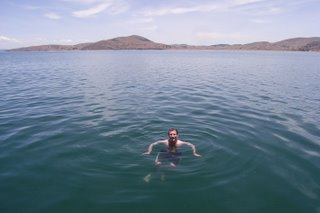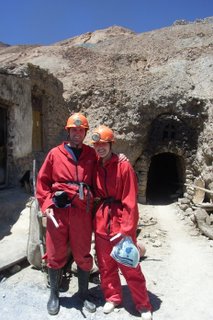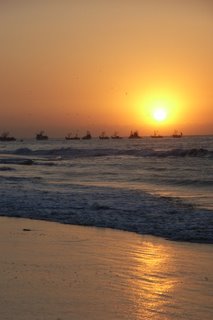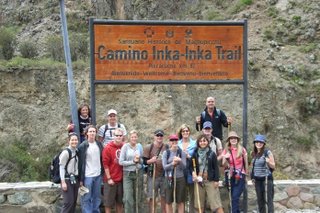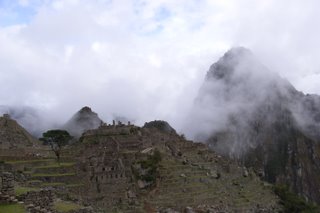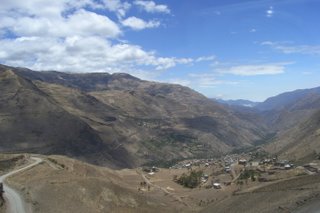 We´re in heaven (more commonly referred to as Argentina)! Apologies for the gap since we last wrote - not sure why it has taken so long.... our only explanation is that we have been too busy enjoying the good life to take time out to write!
We´re in heaven (more commonly referred to as Argentina)! Apologies for the gap since we last wrote - not sure why it has taken so long.... our only explanation is that we have been too busy enjoying the good life to take time out to write! As its been over a month there is a fair bit to say... so for those of you who want the summarised version, here are a few of our observations on Argentina:
Cosmopolitan: Argentina is very ´cosmopolitan. Lots of bars, cafes and styley people. It is a mix of beautiful colonial architecture, modern European living and Latin American culture. These things fuse together to make a perfect holiday destination.
 Food: The food is unlike that we have experienced anywhere else in South America. There is a great mix of traditional Argentinean parillas (where they serve beautiful steaks), modern restaurants with beautiful seafood and modern cuisine. (Pic: Lunch in La Boca)
Food: The food is unlike that we have experienced anywhere else in South America. There is a great mix of traditional Argentinean parillas (where they serve beautiful steaks), modern restaurants with beautiful seafood and modern cuisine. (Pic: Lunch in La Boca)Wine: The red wine is superb..... especially for the price.... We have been careful in our research on this front, and have left no stone unturned when it comes to experiencing this aspect of Argentina. Wine is so important here that in many restaurants the length of the wine list far exceeds that of the menu. We like it.
Affordable: For anyone shopping with a foreign currency (even the NZ dollar!), Argentina is very affordable. A bottle of quite drinkable red can be purchased at a restaurant for 12 pesos (that's about NZ$5). A whole meal for 2 in a nice restaurant (including a very nice bottle of wine) can cost as little as $NZ50. The cost of food etc seems to be around half what you would pay in NZ (or less when it comes to wine). You can live extremely cheaply, or, you can do what we seem to.... and spend almost what you would in NZ and eat and drink like royalty!
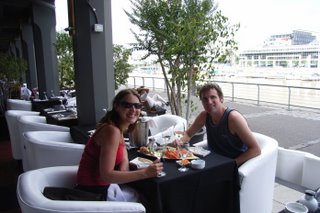 People: The people here are extremely attractive. As we are a happily married couple, there is probably not more we can say here.
People: The people here are extremely attractive. As we are a happily married couple, there is probably not more we can say here.Climate: The weather has been fantastic. We´ve had sun everyday and temperatures have ranged from very mild (15-25°C) to very hot (30-35°C). Not looking forward to the London winter!
Lifestyle: The lifestyle here is very much one of eat late, stay out late and if you live outside Buenos Aries, have a siesta in the afternoon. Some clubs don´t open until midnight, and most people turn up around 2am and stay until daylight. I am now sure that Sanjay is Argentinean.
White is black: Argentineans love to wear white. This is especially so for the women, however is also apparrent with men.... yet further proof that Sanjay is part Argentinean.
For those of you who are suckers for punishment.... here is the full uncensored version......
Salta
Last time we wrote we had just arrived in Salta, a small city in the far north of Argentina. For us Salta was a European oasis after months spent in ´South America´. It is a beautiful city, with plenty of great colonial buildings. It is not ´touristy´, however its population combined with tourists (South American and foreign) ensures that there are no shortage of cafes, bars and restaurants. Its fair to say that our week here was very relaxed.... sipping, shopping, eating and relaxing.
 The pace of life here was fairly peaceful compared to other Latin American cities and the tradition of a ´siesta´ is alive and well. For us the siesta took a bit of getting used to. For the first couple of days we would enjoy a sleep in and get out and about around 11am, only to find most shops and other businesses would close up at 12 and not reopen until 4:30 or 5pm. Fortunately cafes do not have the benefil of the seista, and so we could hunker down in one until life emerged post-siesta!
The pace of life here was fairly peaceful compared to other Latin American cities and the tradition of a ´siesta´ is alive and well. For us the siesta took a bit of getting used to. For the first couple of days we would enjoy a sleep in and get out and about around 11am, only to find most shops and other businesses would close up at 12 and not reopen until 4:30 or 5pm. Fortunately cafes do not have the benefil of the seista, and so we could hunker down in one until life emerged post-siesta!Salta also has no shortage of stray dogs. One evening while sitting at a restaurant table in the street one sat with us in one of our spare chairs. The repeated attempts of restaurant staff to eject him did not seem to phase him and since we had been subject to such attempts by bar staff in our past we felt a real connection with him. This began our relationship with Baxter. He followed us to our taxi that night, joined us in a park one day (until we all got kicked off the grass) and also found us at another bar where he sat and enjoyed a drink with us. We really bonded with Baxter and he joins the long list of great people (and now animals) we have crossed paths with on the trip. (Above, Baxter, our furry gentleman friend)
Cafayate - the home of Torrontes
From Salta we began our trip south to Mendoza. As we were going overland by bus and it is a long way, we decided to break up the trip with a couple of stops. What better place to take a break than Cafayate... a small town in the north which is home to ´torrontes´ a white wine variety which we understand is pretty much only grown in Argentina. Its hard to describe... but is very floral and not too bad on a hot Argentinean day.
 Cafayate was very quiet...... with only the odd tourist on bikes to spoil the peace. Feeling guilty after not doing any sightseeing in Salta we packed our day here full of activities. First things first, we hired bikes and took to the road in search of wineries. We visited Etchart (one of the biggest producers in the area) and had a tour of the winery. Like all our winery tours here, we were shown right through the winery, as workers lined the bottling line and forklifts wizzed past with pellets of wine...... it seems Argentina is free of OSH restrictions still! We were also pleasantly surprised to find that their award wining ´top of the line´ red wine sold for just 40 pesos (that´s about NZ20!). Two more wineries and then a peddle back to town.
Cafayate was very quiet...... with only the odd tourist on bikes to spoil the peace. Feeling guilty after not doing any sightseeing in Salta we packed our day here full of activities. First things first, we hired bikes and took to the road in search of wineries. We visited Etchart (one of the biggest producers in the area) and had a tour of the winery. Like all our winery tours here, we were shown right through the winery, as workers lined the bottling line and forklifts wizzed past with pellets of wine...... it seems Argentina is free of OSH restrictions still! We were also pleasantly surprised to find that their award wining ´top of the line´ red wine sold for just 40 pesos (that´s about NZ20!). Two more wineries and then a peddle back to town. In the afternoon we took a tour of an area of valleys just out of Cafayate called Quebrada de Cafayate. Here the rock formations have eroded over time to reveal layers of different colours and unusual shapes. Although we were in two minds about whether to do this trip, we did actually enjoy it). Our ´guide´ was hopeless (basically just drove the group around and flirted with two Argentinean girls) but did come into his own in one cave called ´The Ampitheatre´ when he picked up a guitar and sung while a thunder storm broke out. Pretty cool to hear the booming thunder mixed with this guy´s tunes.
In the afternoon we took a tour of an area of valleys just out of Cafayate called Quebrada de Cafayate. Here the rock formations have eroded over time to reveal layers of different colours and unusual shapes. Although we were in two minds about whether to do this trip, we did actually enjoy it). Our ´guide´ was hopeless (basically just drove the group around and flirted with two Argentinean girls) but did come into his own in one cave called ´The Ampitheatre´ when he picked up a guitar and sung while a thunder storm broke out. Pretty cool to hear the booming thunder mixed with this guy´s tunes.From Cafayate we bused to Tucuman another city en-route to Mendoza (again a stop to break up the trip). Not much to say about Tucuman, except that it was hot and was where the abundance of stylish dressers became more apparent to us. After a day and night here we hopped on a night bus to Mendoza.
Mendoza - a desert full of Malbec
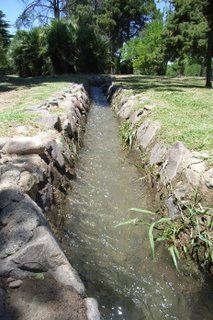 Mendoza is a small city (130,000 pop) tucked in by the Andes (to the east of Santiago). The news to us was that it is in the middle of the desert, but to look at it you wouldn´t know it - the streets are lined with lush trees and like all Argentinean cities, there are plenty of lush green plazas scattered around the city. This is all made possible by open air aqueducts (used even prior to Spanish settlement) that irrigate the city thanks to melting snow in the Andes. This is the same water that makes it possible for the grapes which produce 70% of Argentina´s wine to be grown in this desert which surrounds Mendoza.
Mendoza is a small city (130,000 pop) tucked in by the Andes (to the east of Santiago). The news to us was that it is in the middle of the desert, but to look at it you wouldn´t know it - the streets are lined with lush trees and like all Argentinean cities, there are plenty of lush green plazas scattered around the city. This is all made possible by open air aqueducts (used even prior to Spanish settlement) that irrigate the city thanks to melting snow in the Andes. This is the same water that makes it possible for the grapes which produce 70% of Argentina´s wine to be grown in this desert which surrounds Mendoza. It is fair to say that the week we had here had a strong focus on wine. However, when in Rome right?
Our accommodation here was very nice.... an apartment with a big deck from which to enjoy the hot sunny days (average high here in December is 30°C). Not exactly backpacking.... but to be honest.... although we each have two backpacks, I´m not sure I would say we have been backpacking.
 In an attempt to ease into the wine experience we took ourselves by local bus to the nearest wine region (there are 3 main regions), the Maipu valley. Here we again took to the roads on bikes and visited a few of the local wineries.... good times, but you wouldn´t want to get too carried away as the roads are narrow, the trucks on them are large and fast, and the dogs that chase you are less than friendly (nothing like Baxter). Most interesting thing learnt that day was that if a winery does not irrigate using a drip feed system (ie black piping) they simply open the aqueduct gates into the vineyard when required and flood the areas planted with vines. Apparrently this is the traditional way. (Pic is flooding of winery)
In an attempt to ease into the wine experience we took ourselves by local bus to the nearest wine region (there are 3 main regions), the Maipu valley. Here we again took to the roads on bikes and visited a few of the local wineries.... good times, but you wouldn´t want to get too carried away as the roads are narrow, the trucks on them are large and fast, and the dogs that chase you are less than friendly (nothing like Baxter). Most interesting thing learnt that day was that if a winery does not irrigate using a drip feed system (ie black piping) they simply open the aqueduct gates into the vineyard when required and flood the areas planted with vines. Apparrently this is the traditional way. (Pic is flooding of winery)Not having satisfied our cravings (and with our bums not up to further biking) we booked the next day for a full day ´premium´ tour of Valle de Uco, to the south of Mendoza. This region has great scenery as it is surrounded by vines and has the snow capped Andes as its backdrop. It is also emerging as the most prestigious Mendoza region as the elements here produce a great wine.
 Guided by Anna, a recent law school graduate, we visited 3 wineries over the course of the day, each of which was very different. Our first stop was La Azul, a small winery owned by 2 Argentinean businessmen. The winery is a hobby for them and produces just 30,000L per year. Our tasting here was carried out in the room where the vats are housed and barrels stored - basically the only building on site. Here we tasted 3 wines, two of which we sampled straight from the barrel...... noticing how experienced Michelle was with a glass of wine in hand the guide at the winery even allowed her to pour her own glasses from the barrel! Included in our tasting from the barrel was their top wine, of which from the last vintage only 600 bottles reached the market (all of which sold to a single buyer for 80 pesos each .... NZ$40). The tasting was unlike any other we had experienced in NZ - even the wine glasses were large fine glasses of the type you would expect at a nice restaurant (with large tastings to match....).
Guided by Anna, a recent law school graduate, we visited 3 wineries over the course of the day, each of which was very different. Our first stop was La Azul, a small winery owned by 2 Argentinean businessmen. The winery is a hobby for them and produces just 30,000L per year. Our tasting here was carried out in the room where the vats are housed and barrels stored - basically the only building on site. Here we tasted 3 wines, two of which we sampled straight from the barrel...... noticing how experienced Michelle was with a glass of wine in hand the guide at the winery even allowed her to pour her own glasses from the barrel! Included in our tasting from the barrel was their top wine, of which from the last vintage only 600 bottles reached the market (all of which sold to a single buyer for 80 pesos each .... NZ$40). The tasting was unlike any other we had experienced in NZ - even the wine glasses were large fine glasses of the type you would expect at a nice restaurant (with large tastings to match....).From here we went on to Andeluna, a much grander and very new winery, which sells only domestically and in some states in the US. Demand far exceeds supply for them, and thus prices for their wine started at around US$30 per bottle.... quite a contrast to La Azul! We were again shown the vineyard and right through the winery and so in addition to tasting, you also learned a lot about how different wineries produce their wines.
 Next on to Salentien, probably the largest in the area and owned by a Dutch businessman who has spent a fortune on the winery. The winery, with a star shaped interior is quite an architectural feat (see view from level 1 into barrel room to the right)! We had a great 3 course lunch here followed by tasting. Like Andeluna, the winery buildings are very new - apparently a lot of foreign money has poured into the industry since the 2001 crisis made investment here so much more affordable (until then the peso had been pegged 1 for 1 to the USD). It was a great day and we learned (and tasted) a heap!
Next on to Salentien, probably the largest in the area and owned by a Dutch businessman who has spent a fortune on the winery. The winery, with a star shaped interior is quite an architectural feat (see view from level 1 into barrel room to the right)! We had a great 3 course lunch here followed by tasting. Like Andeluna, the winery buildings are very new - apparently a lot of foreign money has poured into the industry since the 2001 crisis made investment here so much more affordable (until then the peso had been pegged 1 for 1 to the USD). It was a great day and we learned (and tasted) a heap!It was in Mendoza where we had our biggest ´it´s a small world´ experience so far in the trip. While at a wine tasting in town, we bumped into one of the only 2 people we knew in Argentina prior to the trip (only we thought they were in Buenos Aries). Luke and Suzie (who we had met only once or twice through Dazza) had done a trip like ours to South America 4 years ago. Like us, they vowed to come back and earlier this year they did and now work in Mendoza. This was a great chance encounter and Luke and Suzie really looked after us for the rest of our time there.
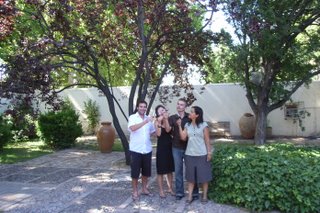 As it happened, Suzie was working as a wine tour guide, so the next day we found ourselves booking onto our second `premium´ tour, this time of the third region, Lujan de Cuyo. With Suzie as our guide and Luke along (he was writing an article on the tour) we had another fantastic day. I have raved on enough about wine tours and tastings, but in short.... we did another barrel tasting, visited one of the oldest wineries in the area and had a beautiful 5 course wine matched lunch. Another fantastic day and we left knowing a little bit more about wine and how it is made here. (Pic, us with Suzie and Luke)
As it happened, Suzie was working as a wine tour guide, so the next day we found ourselves booking onto our second `premium´ tour, this time of the third region, Lujan de Cuyo. With Suzie as our guide and Luke along (he was writing an article on the tour) we had another fantastic day. I have raved on enough about wine tours and tastings, but in short.... we did another barrel tasting, visited one of the oldest wineries in the area and had a beautiful 5 course wine matched lunch. Another fantastic day and we left knowing a little bit more about wine and how it is made here. (Pic, us with Suzie and Luke)Of course there is more to life than wine. When we weren´t drinking, we were eating, but when these things were done we also spent plenty of time exploring the area and experiencing the culture. In addition to its tree lined streets and plazas, Mendoza has a 400 hectare park (Parque General San Martin). The park is home to a man made lake, used to irrigate the city and is positioned in the direction of the prevailing wind to add humidity to the otherwise dry desert air. quite clever really. The cultural highlight was sitting a terrace cafe outside the Hyatt, which is a huge old colonial style building, listing to jazz by moonlight.
All in all Mendoza was a fantastic place.... we will be back!
Santiago - Chile
We took a bus for the 6 hour journey across the Andes and into Chile.
 We had been told to expect spectacular views and scenery along the way, and while it was quite impressive, we have probably become a bit spoilt in this respect from the scenery we have seen further north on the trip.
We had been told to expect spectacular views and scenery along the way, and while it was quite impressive, we have probably become a bit spoilt in this respect from the scenery we have seen further north on the trip.We had 3 days in Santiago.... this time in accommodation that would be fit for a true backpacker, but which was central in its location. Santiago was a busy, bustling city. Once again there are beautiful plazas, parks and colonial buildings. It has a great underground rail system and we quickly found ourselves using this to get around the city and region.
The highlights for us while here were probably a gondola ride up to a park that overlooks the city. From the top there is a great panoramic view across Santiago. There is also a huge Christ the Redeemer statue at the top which overlooks the city. Open air church services are held at the top, which I am sure would be an amazing experience to attend.
 We enjoyed a day trip out to the coastal port town of Valparaiso. The unexpected highlight here was a trip to Pablo Neruda`s hillside house (he is a Noble prize winning poet.... but we had never heard of him.... sorry mum....). It seems that the guy was fairly eccentric and his house is filled with odd bits and pieces, each with a great story. For example, he was given a portrait of a woman which hung on his wall..... and so as to ensure that she didn´t get lonely, he purchased a portrait of a man and hung it on the wall opposite! He also enjoyed things nautical and his home overlooked the busy Valparaiso port. A cool little town to visit. (pic, view from lunch)
We enjoyed a day trip out to the coastal port town of Valparaiso. The unexpected highlight here was a trip to Pablo Neruda`s hillside house (he is a Noble prize winning poet.... but we had never heard of him.... sorry mum....). It seems that the guy was fairly eccentric and his house is filled with odd bits and pieces, each with a great story. For example, he was given a portrait of a woman which hung on his wall..... and so as to ensure that she didn´t get lonely, he purchased a portrait of a man and hung it on the wall opposite! He also enjoyed things nautical and his home overlooked the busy Valparaiso port. A cool little town to visit. (pic, view from lunch)The only downside to Chile is that it is relatively expensive. We found that things cost about the same or a little more than they do in NZ..... a bit tough on the wallet after weeks travelling in Bolivia and then Argentina!
Roll on Buenos Aires.......
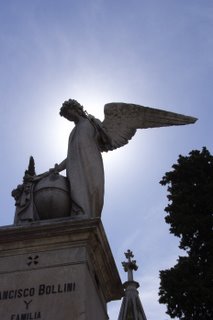 Our flight from Santiago to Buenos Aires provided us with a fantastic view of the Andes. I don´t think we had appreciated how immense they were until we saw them from the air!
Our flight from Santiago to Buenos Aires provided us with a fantastic view of the Andes. I don´t think we had appreciated how immense they were until we saw them from the air!In Buenos Aires we checked into our home for the next week... a small B&B in the heart of Palermo (www.palermoviejobb.com). Our stay there has been fantastic. Ariel the owner was quick to sit us down and talk us through the city and what we needed to see. Armed with a map he gave us (which incidentially points out the location of gay friendly businesses all over BA..... in Ariel´s words, the map is gay, but its good!) we have really experienced Buenos Aries. (Pic is Ricoletta cemetary)
Highlights have been :
Living in Palermo...... Palermo is the heart of the Buenos Aries cafe, restaurant and designer clothing store area. Every street is a mix of residential buildings and places to eat, drink and shop. Naturally it is a place Michelle could easily get lost in for weeks! It has all been on our doorstep, which is dangerous, but great!
 Tango in La Boca..... We spent a day looking around La Boca.... a working class neighbourhood and home to Maradona Diego´s football club and tango. Despite the Lonely Planet´s warnings not to leave ´tourist areas´, we ventured down back streets (complete with piles of rotting rubbish everywhere you looked) in search of a local restaurant Ariel had recommended we visit. Sure enough we found it nestled amongst industrial buildings..... it had been around for about 60 years, was very local and the food was stunning (and cheap!) and the wine list extensive. From here we ventured into the tourist area and watched tango in the street, and back out of the tourist area, a local rock band play to locals on a soccer pitch.
Tango in La Boca..... We spent a day looking around La Boca.... a working class neighbourhood and home to Maradona Diego´s football club and tango. Despite the Lonely Planet´s warnings not to leave ´tourist areas´, we ventured down back streets (complete with piles of rotting rubbish everywhere you looked) in search of a local restaurant Ariel had recommended we visit. Sure enough we found it nestled amongst industrial buildings..... it had been around for about 60 years, was very local and the food was stunning (and cheap!) and the wine list extensive. From here we ventured into the tourist area and watched tango in the street, and back out of the tourist area, a local rock band play to locals on a soccer pitch.Ricoletta cemetery.... Nestled near the city is the historic Ricoletta cemetery... Evita`s resting place. Although one must go to see Evita´s grave, the cemetery is more spectacular for the mix of grand crypts, some of which have been lovingly cared for over the past 120 years, others which are in a sad state of disrepair.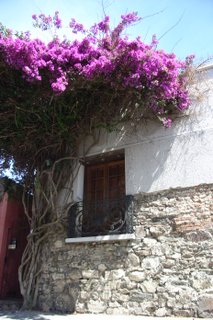 Sunday in San Telmo..... Sunday in San Telmo the streets convert to a massive antique (and other old stuff) market. You could spend (and we did) hours here looking at all sorts of stuff.... matchbox toys from your childhood (remember the light blue car transporter Scott?), tonnes of coloured glassware from the 60s (had to drag ourselves away) and several deco stores where Bruce and Alan would be in their element!
Sunday in San Telmo..... Sunday in San Telmo the streets convert to a massive antique (and other old stuff) market. You could spend (and we did) hours here looking at all sorts of stuff.... matchbox toys from your childhood (remember the light blue car transporter Scott?), tonnes of coloured glassware from the 60s (had to drag ourselves away) and several deco stores where Bruce and Alan would be in their element!
Uruguay.... We took a 1 hour ferry across the river to Colonia, a small town in Uruguay. The city is a world heritage site and has extremely rustic cobble-stoned streets and stone houses. It is like we would picture an old Italian or Spanish village and was a nice peaceful break from bustling BA.
Of course we have done heaps more here.... enjoyed fantastic food and wine, shopped, visited galleries, parks and plazas, late nights out in dance clubs (complete with g-string clad dancing girls, drag queens and freestyle (ie BOP) dancers), wandered through markets, weaved around the city on local buses and just tried to absorb as much of this great city as we can.
As you can see - we love Argentina and we are already planning a return journey here. From here we head to Iguazu falls, then on to Brazil for a couple of weeks mainly spent on beaches. Will try and let you know about that before we leave South America.
Hope this finds you well. Don`t get too carried away in the silly season, have a great Christmas and New Year. We have Christmas in Rio and New Year in the air en-route to London where we arrive on New Years Day.
 After that we joined a Tucan tour for 36 days in Quito and did the trip below ending in La Paz, Bolivia.......
After that we joined a Tucan tour for 36 days in Quito and did the trip below ending in La Paz, Bolivia.......


